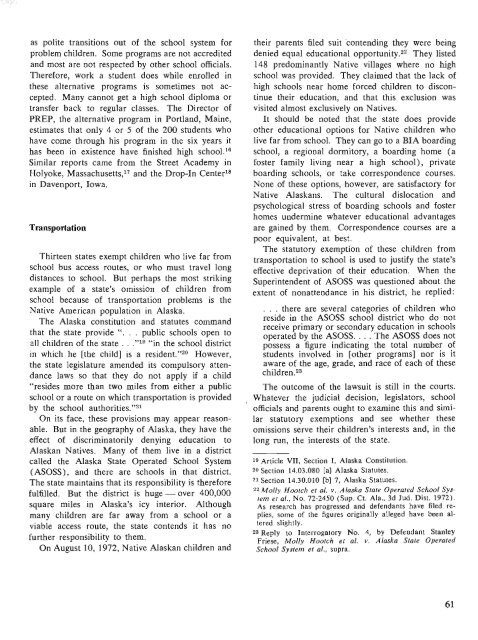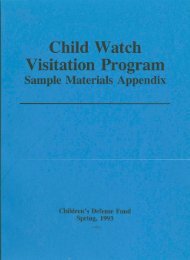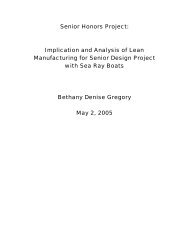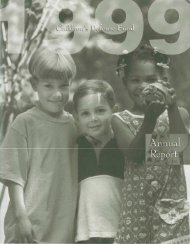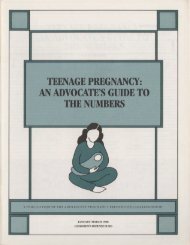children out of school in america - University of Tennessee Digital ...
children out of school in america - University of Tennessee Digital ...
children out of school in america - University of Tennessee Digital ...
You also want an ePaper? Increase the reach of your titles
YUMPU automatically turns print PDFs into web optimized ePapers that Google loves.
as polite transitIOns <strong>out</strong> <strong>of</strong> the <strong>school</strong> system for<br />
problem <strong>children</strong>. Some programs are not accredited<br />
and most are not respected by other <strong>school</strong> <strong>of</strong>ficials.<br />
Therefore, work a student does while enrolled <strong>in</strong><br />
these alternative programs is sometimes not accepted.<br />
Many cannot get a high <strong>school</strong> diploma or<br />
transfer back to regular classes. The Director <strong>of</strong><br />
PREP, the alternative program <strong>in</strong> Portland, Ma<strong>in</strong>e,<br />
estimates that only 4 or 5 <strong>of</strong> the 200 students who<br />
have come through his program <strong>in</strong> the six years it<br />
has been <strong>in</strong> existence have f<strong>in</strong>ished high <strong>school</strong>. 16<br />
Similar reports came from the Street Academy <strong>in</strong><br />
Holyoke, Massachusetts,17 and the Drop-In Center 18<br />
<strong>in</strong> Davenport, Iowa.<br />
Transportation<br />
Thirteen states exempt <strong>children</strong> who live far from<br />
<strong>school</strong> bus access r<strong>out</strong>es, or who must travel long<br />
distances to <strong>school</strong>. But perhaps the most strik<strong>in</strong>g<br />
example <strong>of</strong> a state's omission <strong>of</strong> <strong>children</strong> from<br />
<strong>school</strong> because <strong>of</strong> transportation problems is the<br />
Native American population <strong>in</strong> Alaska.<br />
The Alaska constitution and statutes command<br />
that the state provide ". . . public <strong>school</strong>s open to<br />
all <strong>children</strong> <strong>of</strong> the state ..."19 "<strong>in</strong> the <strong>school</strong> district<br />
<strong>in</strong> which he [the child] is a resident."20 However,<br />
the state legislature amended its compulsory attendance<br />
laws so that they do not apply if a child<br />
"resides more than two miles from either a public<br />
<strong>school</strong> or a r<strong>out</strong>e on which transportation is provided<br />
by the <strong>school</strong> authorities. "21<br />
On its face, these provisions may appear reasonable.<br />
But <strong>in</strong> the geography <strong>of</strong> Alaska, they have the<br />
effect <strong>of</strong> discrim<strong>in</strong>atorily deny<strong>in</strong>g education to<br />
Alaskan Natives. Many <strong>of</strong> them live <strong>in</strong> a district<br />
called the Alaska State Operated School System<br />
(ASOSS), and there are <strong>school</strong>s <strong>in</strong> that district.<br />
The state ma<strong>in</strong>ta<strong>in</strong>s that its responsibility is therefore<br />
fulfilled. But the district is huge - over 400,000<br />
square miles <strong>in</strong> Alaska's icy <strong>in</strong>terior. Although<br />
many <strong>children</strong> are far away from a <strong>school</strong> or a<br />
viable access r<strong>out</strong>e, the state contends it has no<br />
further responsibility to them.<br />
On August 10, 1972, Native Alaskan <strong>children</strong> and<br />
their parents filed suit 'contend<strong>in</strong>g they were be<strong>in</strong>g<br />
denied equal educational opportunity.22 They listed<br />
148 predom<strong>in</strong>antly Native villages where no high<br />
<strong>school</strong> was provided. They claimed that the lack <strong>of</strong><br />
high <strong>school</strong>s near home forced <strong>children</strong> to discont<strong>in</strong>ue<br />
their education, and that this exclusion was<br />
visited almost exclusively on Natives.<br />
It should be noted that the state does provide<br />
other educational options for Native <strong>children</strong> who<br />
live far from <strong>school</strong>. They can go to a BIA board<strong>in</strong>g<br />
<strong>school</strong>, a regional dormitory, a board<strong>in</strong>g home (a<br />
foster family liv<strong>in</strong>g near a high <strong>school</strong>), private<br />
board<strong>in</strong>g <strong>school</strong>s, or take correspondence courses.<br />
None <strong>of</strong> these options, however, are satisfactory for<br />
Native Alaskans. The cultural dislocation and<br />
psychological stress <strong>of</strong> board<strong>in</strong>g <strong>school</strong>s and foster<br />
homes underm<strong>in</strong>e whatever educational advantages<br />
are ga<strong>in</strong>ed by them. Correspondence courses are a<br />
poor equivalent, at best.<br />
The statutory exemption <strong>of</strong> these <strong>children</strong> from<br />
transportation to <strong>school</strong> is used to justify the state's<br />
effective deprivation <strong>of</strong> their education. When the<br />
Super<strong>in</strong>tendent <strong>of</strong> ASOSS was questioned ab<strong>out</strong> the<br />
extent <strong>of</strong> nonattendance <strong>in</strong> his district, he replied:<br />
. . . there are several categories <strong>of</strong> <strong>children</strong> who<br />
reside <strong>in</strong> the ASOSS <strong>school</strong> district who do not<br />
receive primary or secondary education <strong>in</strong> <strong>school</strong>s<br />
operated by the ASOSS.... The ASOSS does not<br />
possess a figure <strong>in</strong>dicat<strong>in</strong>g the total number <strong>of</strong><br />
students <strong>in</strong>volved <strong>in</strong> [other programs] nor is it<br />
aware <strong>of</strong> the age, grade, and race <strong>of</strong> each <strong>of</strong> these<br />
<strong>children</strong>. 23<br />
The <strong>out</strong>come <strong>of</strong> the lawsuit is still <strong>in</strong> the courts.<br />
Whatever the judicial decision, legislators, <strong>school</strong><br />
<strong>of</strong>ficials and parents ought to exam<strong>in</strong>e this and similar<br />
statutory exemptions and see whether these<br />
omissions serve their <strong>children</strong>'s <strong>in</strong>terests and, <strong>in</strong> the<br />
long run, the <strong>in</strong>terests <strong>of</strong> the state.<br />
19 Article VIl, Section I. Alaska Constitution.<br />
20 Section 14.03.080 [aj Alaska Statutes.<br />
21 Section 14.30.010 [bj 7, Alaska Statutes.<br />
22 Molly Hootch et 01. v. A laska State Operated School System<br />
et 01.• No. 72-2450 (Sup. Ct. Ala., 3d Jud. Disl. 1972).<br />
As research has progressed and defendants have filed replies,<br />
some <strong>of</strong> the figures orig<strong>in</strong>ally alleged have been altered<br />
slightly.<br />
23 Reply to Interrogatory No.4, by Defendant Stanley<br />
Friese, Molly Hootch et 01. v. Alaska State Operated<br />
School System et 01., supra.<br />
61


